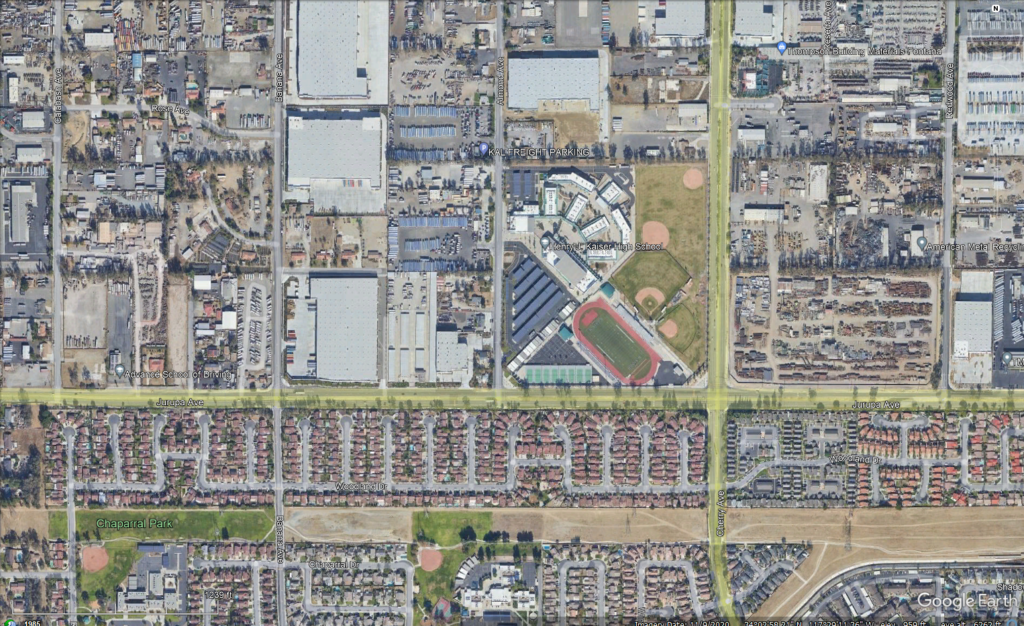E-Commerce or Community? Rethinking the Land Use Debate Over Warehouses
Bess Morin | May 23, 2023

E-commerce retail spending has more than doubled between 2017 and 2022, and is projected to continue to increase, to more than 1.7 trillion by 2027. This growth in e-commerce has contributed to the growth of warehousing development in many regions, including Southern California, Pennsylvania and New Jersey. Many concerned about the proliferation of warehouses focus on this as primarily a land use issue, but what larger forces are guiding this trend? Why has e-commerce grown so rapidly, and what are the social and environmental impacts?
Impacts of Warehouse Development
Recent headlines from newspaper articles have brought attention to the impacts of warehouse expansion in communities and the environment. According to an article in Bloomberg, 40% of the goods that enter the United States come through the ports of Long Beach and Los Angeles. This geographic proximity to the largest port in the continental US puts Southern California in a vulnerable position to the negative environmental impacts of the supply, transport, and distribution industries.
Although often considered light industry, warehousing is a concern for people’s health, due to the increase in truck traffic. Air pollution from diesel emissions leads to poor health outcomes for residents. This is particularly concerning in areas where industrial zoning and truck traffic are in close proximity to schools and residential areas.

In addition to contributing to pollution burdens, e-commerce has also been criticized for taking money out of local economies. This is particularly impactful for the resilience of a community during difficult economic times. Some cities have found ways to encourage local small businesses, this effort can contribute to a more resilient city by keeping investments circulating within the community.
Some argue that this increase in warehousing has been a job generator, however investment in robotics and automation calls into question this argument. Maybe this has been a job generator right now, though with increased investment in automation the resilience and longevity of these jobs is questionable. Although warehousing does provide jobs, these positions often do not provide benefits, are low paying, and workers may be exposed to unsafe working conditions.
If warehouse facilities have serious environmental impacts, threaten local economies, and offer limited benefits of short-term, low-wage employment, why are cities so often welcoming them into their communities? One explanation lies in the role they play in satisfying our desire to consume.
Consumerism
Our habits of buying and consuming are linked to how we as humans behave and think. Researchers have related e-commerce to our need for instant gratification. This need stems from our tendency to discount outcomes in the future, relative to outcomes in the present. This tendency is linked to Maslow’s Hierarchy of Needs, a theory in psychology that has been used by marketers to target products to people. Maslow’s Hierarchy argues that we are motivated first by fulfilling physiological needs, followed by safety, love/belonging, esteem, and lastly self-actualization. E-commerce allows us to quickly address at least some of these needs in a way that minimizes uncertainty (will the store have what I want if I make the effort to go there?) and maximizes efficiency of our time, presumably allowing us to focus on other needs.
Maslow’s Hierarchy has many critiques, including its emphasis on the self. This theory situates personal growth and development as the highest need, only to be reached after all others are met. Critics argue that an emphasis on community versus the individual is of greater importance to human well-being. We don’t exist in isolation. Studies have confirmed that social relations are crucial to our health and well-being.
In an interview with Scientific America, scientist Mathew Lieberman argues that our need to connect socially is as essential as our need for food in water. He explains how being connected to others is a motivator in and of itself for people. Although some believe behaviors are mainly guided by self-interest, the need for connection is a necessity. Maslow’s Hierarchy acknowledges this, but an alternative view thinks of the self as a social phenomenon that is highly connected to and influenced by our social environment.
If businesses and marketers are designing products and marketing campaigns to respond to our individual psychological needs, could a similar approach be used to design our built environment to connect to our need for social relations?
Social Connections and the Built Environment
Land use can greatly impact the potential for social connections. Residential housing directly next to industrial land use clearly impacts the physical environment, with increased pollution, truck traffic, noise pollution, and safety for residents and pedestrians. Exposure to these conditions not only has negative physical health effects, but encourages isolation, as one retreats into their personal space in an effort to avoid this environment. In contrast, when communities are designed in a way that residents are in close proximity to one another, and in close proximity to essential services such as transportation, health care, food, and community gathering spaces, there is greater potential for social relations to occur. Adjacency to services as well as walkability are conditions that contribute to better health and wellbeing for residents and more connected communities.

Socially connected communities are more resilient. Social Isolation is often times attributed to an individual condition; however as Healthy Places by Design explains, it is rooted in community design, social norms, and systemic injustices. Cities should consider prioritizing social connection within all stages of planning as a condition that can guide land use decisions and prioritize pro-social land use over land use that privileges consumerism, and creates harmful health conditions for communities, such as warehousing.
Healthy places by Design presents actions as a starting point for this approach. Examples include implementing community- led and community-based solutions, meaning residents should not just be invited to join, but lead efforts that matter most to their community and lives. Another action item presented is to allocate resources to community assets that improve connectivity. This means prioritizing funds towards community centers, libraries, youth services, mental health services, and housing.
What values are communicated when investment goes towards warehousing and not towards fostering neighborhood social interaction? The trend towards warehousing is symptomatic of an increase in e-commerce, and this increase in e-commerce, particularly by multi-national corporations, is a symptom of larger societal values that prioritize profit and the immediate needs of the self. Approaches such as those advocated in Healthy Places by Design offer an alternative that communicates the value of community and social connections. When considered in this way, the choice that leads to long-term health and well-being is clear.

Bess is a graduate student in the Master’s of Landscape Architecture program at California State Polytechnic University Pomona. She is originally from Massachusetts and earned her B.F.A. from Syracuse University. She is interested in the ways in which spaces promote mental and physical health. She seeks to understand how to best serve our world through thoughtful designs that promote human and ecosystem health and reveal our interconnectedness.